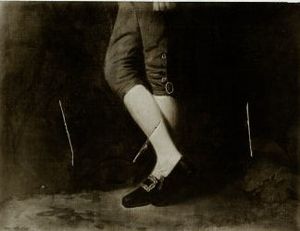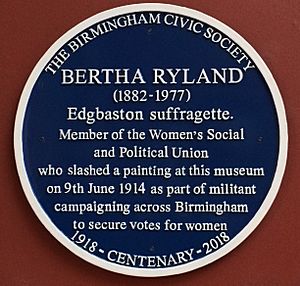Bertha Ryland facts for kids

Bertha Wilmot Ryland (born October 12, 1882 – died April 1977) was a brave suffragette. She was a member of the Women's Social and Political Union (WSPU). This group fought hard for women to get the right to vote. In 1914, Bertha damaged a painting in the Birmingham Museum and Art Gallery. After this, she went on a hunger strike in Winson Green Prison in Birmingham. For her courage, she received the WSPU's Hunger Strike Medal.
Contents
Bertha Ryland: A Champion for Women's Votes
Early Life and Family
Bertha Ryland was born in Edgbaston, Birmingham. She was the youngest of five children. Her mother, Alice Ryland, was also a strong supporter of women's rights. Alice was part of the Birmingham Women's Suffrage Society in the 1870s.
In 1907, Bertha and her mother joined the Women's Social and Political Union (WSPU). They felt the older group was not making enough progress. Bertha worked closely with other important suffragettes like Gladice Keevil and Hilda Burkitt. In 1910, Bertha even started a new WSPU group in Lichfield.
Fighting for the Vote
Bertha Ryland was a very active suffragette. In November 1911, she was sent to Holloway Prison for a week. In March 1912, she took part in a protest in London. During this protest, some windows were broken. Bertha was then sentenced to six months in prison. She spent four months in Winson Green Prison.
While in prison, Bertha went on a hunger strike. This meant she refused to eat. Because of this, she was fed against her will many times. This process, called force-feeding, was very difficult. For her bravery during this time, she received the Hunger Strike Medal. Sadly, this treatment caused lasting harm to her kidney.
Why Suffragettes Took Action
On June 8, 1914, Bertha Ryland, who was 31 years old, protested again. She used a meat cleaver to damage a painting. The painting was called 'Master Thornhill' by George Romney. It was displayed in the Birmingham Museum and Art Gallery. She damaged it three times, causing about £50 worth of damage.
Bertha left a letter explaining her actions. She wrote that she did this to protest the government's unfairness. She felt it was wrong that women were denied the right to vote. She also protested the harsh treatment of suffragettes in prison. After her protest, the art gallery closed for six weeks. When it reopened, security was much tighter.
Bertha was arrested and appeared in court. She refused to take part in the court process. She shouted "No surrender!" as she was taken away. She went on another hunger strike while waiting for her trial. Bertha was too unwell to attend her trial in July. A doctor said it would make her condition worse. She had not yet been sentenced when World War I began. The force-feeding she endured in prison caused permanent kidney damage.
In July 1914, a suffragette newspaper shared Bertha's experience. She described how she was held down and fed through a tube. She said it was a very painful and upsetting experience. She felt very ill and exhausted afterwards. She also felt sad and found it hard to think clearly.
Later Years and Legacy
In 1939, Bertha Ryland was living in Stroud, Gloucestershire. Records show she was unwell at that time.
She received a Coronation Medal in 1953. Her Coronation Medal and her Hunger Strike Medal were sold in 1999 for a good amount of money. Bertha Ryland never married. She passed away in Birmingham in April 1977.
In November 2018, a special blue plaque was placed at the Birmingham Museum and Art Gallery. This plaque honors Bertha Ryland and her protest. It reminds everyone of her important role in the fight for women's votes. The plaque says: "Bertha Ryland (1882-1977) Edgbaston suffragette. Member of the Women's Social and Political Union who slashed a painting at this museum on 9th June 1914 as part of militant campaigning across Birmingham to secure votes for women".




